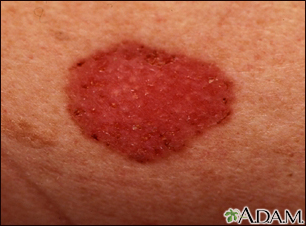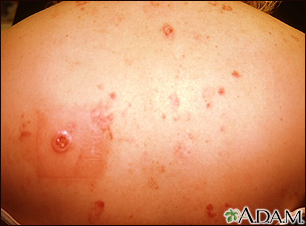Pregnancy SmartSiteTM
Basal cell carcinoma; Rodent ulcer; Skin cancer - basal cell; Cancer - skin - basal cell; Nonmelanoma skin cancer; Basal cell NMSC; Basal cell epithelioma DefinitionBasal cell cancer is the most common form of cancer in the United States. Most skin cancers are basal cell cancer. Other common types of skin cancer are: CausesThe top layer of the skin is called the epidermis. The bottom layer of the epidermis is the basal cell layer. With basal cancer, cells in this layer are the ones that become cancerous. Most basal cell cancers occur on skin that is regularly exposed to sunlight or other ultraviolet radiation.  This type of skin cancer is most common in people over age 50. But it can also occur in younger people who have had extensive sun exposure. Basal cell cancer is almost always slow-growing. It rarely spreads to other parts of the body. You are more likely to develop basal cell cancer if you have:
Other risk factors include:
SymptomsBasal cell cancer usually grows slowly and is often painless. It may not look that different from your normal skin. You may have a skin bump or growth that is:
In some cases, the skin is just slightly raised, or even flat. You may have:
 Exams and TestsYour health care provider will check your skin and look at the size, shape, color, and texture of any suspicious areas. If your provider thinks you might have skin cancer, a piece of skin will be removed. This is called a skin biopsy. The sample is sent to a lab for examination under a microscope. A skin biopsy must be done to confirm basal cell cancer or other skin cancers. The diagnosis cannot be based only on the appearance of your skin. TreatmentTreatment depends on the size, depth, and location of the skin cancer and your overall health. Each treatment has its risks and benefits. You and your provider can discuss the treatment that's right for you. Treatment may involve any of the following:
Support GroupsYou can ease the stress of illness by joining a cancer support group. Sharing with others who have common experiences and problems can help you not feel alone. Outlook (Prognosis)Most of these cancers are cured when treated early. Some basal cell cancers return in the same location. Smaller ones are less likely to come back. Basal cell skin cancer almost never spreads beyond the original location. Left untreated, however, it may spread into surrounding areas and nearby tissues and bone. When to Contact a Medical ProfessionalContact your provider for an appointment if you have a sore or spot on your skin that changes in:
Also contact your provider if a spot becomes painful or swollen, or if it starts to bleed or itch. PreventionExperts disagree about the value of routine skin examinations by your provider. But all agree it's important to know your own skin and to contact your provider if you notice anything unusual. The best way to prevent skin cancer is to reduce your exposure to sunlight. Always use sunscreen:
Other measures to help you avoid too much sun exposure:
ReferencesAmerican Cancer Society website. Skin cancer prevention and early detection. www.cancer.org/content/dam/CRC/PDF/Public/6930.00.pdf. Reviewed April 20, 2017. Accessed October 3, 2023. Dinulos JGH. Premalignant and malignant nonmelanoma skin tumors. In: Dinulos JGH, ed. Habif's Clinical Dermatology. 7th ed. Philadelphia, PA: Elsevier; 2021:chap 21. National Cancer Institute website. Skin cancer treatment (PDQ) - health professional version. www.cancer.gov/types/skin/hp/skin-treatment-pdq#section/_222. Updated March 2, 2023. Accessed July 17, 2023. National Comprehensive Cancer Network website. NCCN Clinical Practice Guidelines in Oncology (NCCN Guidelines): Basal cell skin cancer. Version 2.2024. www.nccn.org/professionals/physician_gls/pdf/nmsc.pdf. Updated September 14, 2023. Accessed October 3, 2023. US Preventive Services Task Force, Mangione CM, Barry MJ, et al. Screening for skin cancer: US Preventive Services Task Force recommendation statement. JAMA. 2023;329(15):1290-1295. PMID: 37071089 pubmed.ncbi.nlm.nih.gov/37071089/. | |
| |
Review Date: 7/1/2023 Reviewed By: Ramin Fathi, MD, FAAD, Director, Phoenix Surgical Dermatology Group, Phoenix, AZ. Also reviewed by David C. Dugdale, MD, Medical Director, Brenda Conaway, Editorial Director, and the A.D.A.M. Editorial team. The information provided herein should not be used during any medical emergency or for the diagnosis or treatment of any medical condition. A licensed medical professional should be consulted for diagnosis and treatment of any and all medical conditions. Links to other sites are provided for information only -- they do not constitute endorsements of those other sites. No warranty of any kind, either expressed or implied, is made as to the accuracy, reliability, timeliness, or correctness of any translations made by a third-party service of the information provided herein into any other language. © 1997- A.D.A.M., a business unit of Ebix, Inc. Any duplication or distribution of the information contained herein is strictly prohibited. | |

 Skin cancer, basal...
Skin cancer, basal... Skin cancer, basal...
Skin cancer, basal... Skin cancer, basal...
Skin cancer, basal... Skin cancer, basal...
Skin cancer, basal... Multiple Basal cel...
Multiple Basal cel... Basal Cell Carcino...
Basal Cell Carcino... Basal cell carcino...
Basal cell carcino... Basal cell cancer
Basal cell cancer
